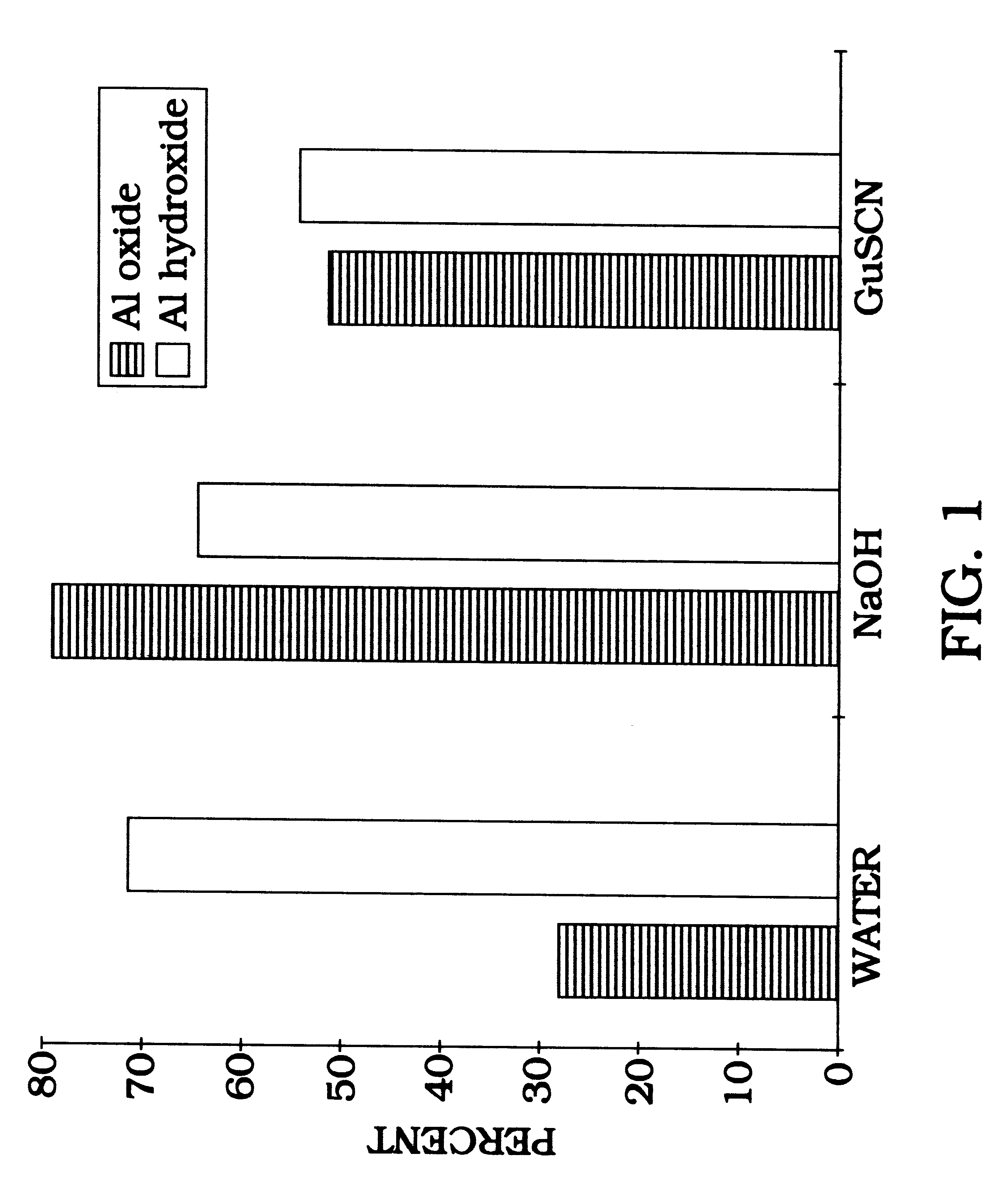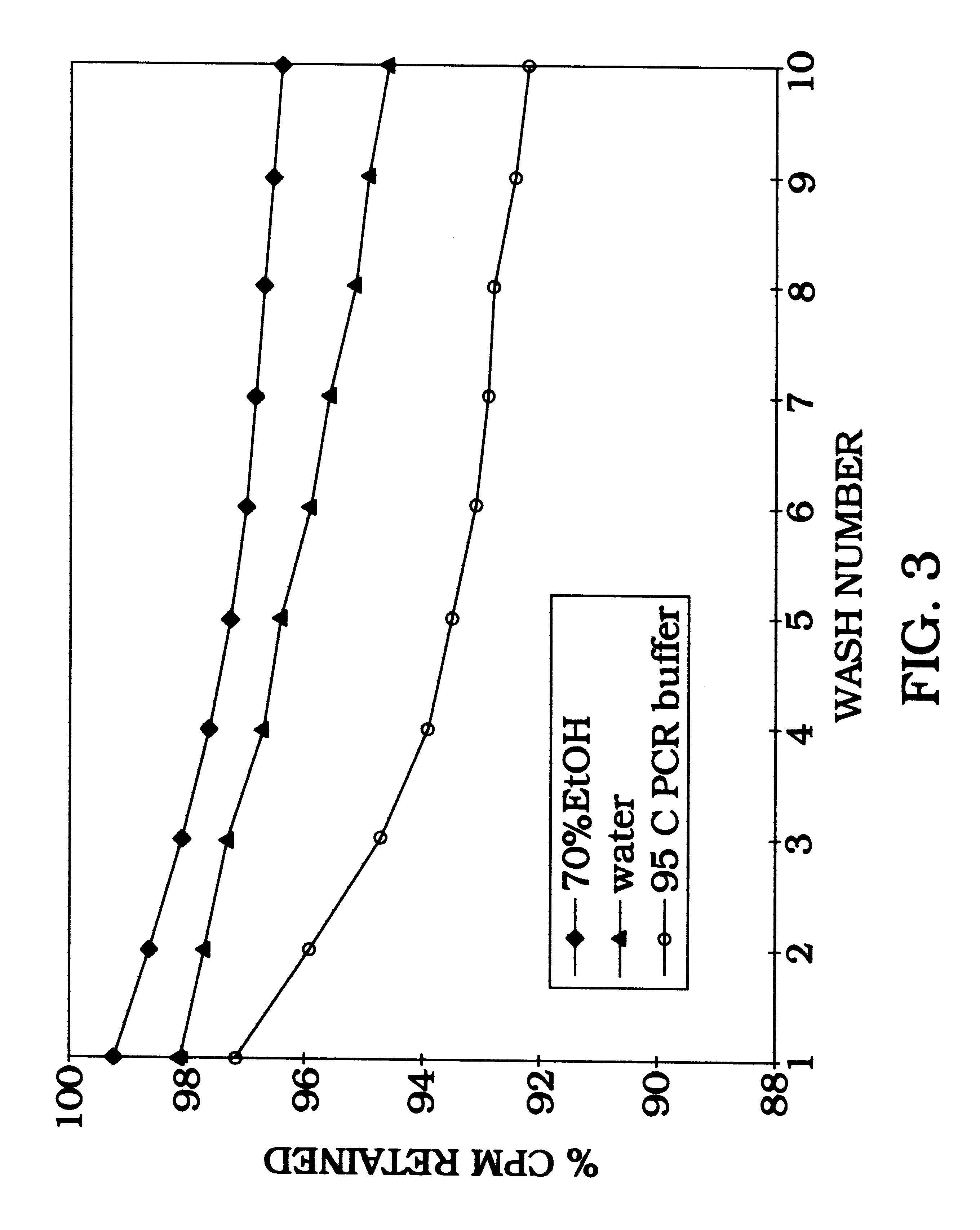Nucleic acid archiving
a technology of nucleic acid and archiving, applied in the field of nucleic acid archiving, can solve the problems of significant cross contamination chance of specimens, laborious nucleic acid analysis, and difficult, if not impossible, to obtain a second confirmatory specimen
- Summary
- Abstract
- Description
- Claims
- Application Information
AI Technical Summary
Benefits of technology
Problems solved by technology
Method used
Image
Examples
example 2
Confirmation of Irreversible Solid Phase Binding of DNA
Radiolabeled DNA (1 ng) is allowed to bind to either aluminum oxide or aluminum hydroxide at room temperature, with rotation, for 1 hour in water (ddH.sub.2 O), 0.1 N NaOH, or 4 M guanidine buffer. The DNA binds to aluminum oxide in water or guanidine thiocyanate buffer. Binding is greatly enhanced by using either NaOH as a binding buffer or aluminum hydroxide beads (FIG. 1). In order to estimate binding capacity of 198 mg aluminum oxide, 1 ng of radiolabeled DNA is added to various concentrations of salmon sperm DNA. More specifically, this procedure estimates the point at which the aluminum oxide becomes saturated so that binding of radiolabeled DNA is blocked (FIG. 2). FIG. 2, presented as the percent DNA bound versus the amount of DNA (in nanograms) bound to the aluminum oxide illustrates the effect of increasing DNA concentration on the binding efficiency of .sup.32 P radiolebeled DNA to 198 mg aluminum oxide. Water binding...
example 3
Gravity Flow Chromatograph
Significant improvement in the sensitivity of DNA detection from specimens of high volume and low concentration is derived based on that capability of aluminum oxide to efficiently bind DNA at high flow rate by chromatography. Radiolabeled DNA is allowed to bind during gravity filtration of either 74-149 .mu.m aluminum oxide beads or 150-212 .mu.m silicon dioxide beads (Sigma, catalog no. G1145)(FIG. 4). The amount of silicon dioxide or aluminum oxide is adjusted such that they both have equal surface area available for DNA binding. DNA (50 ng) binds during gravity filtration when diluted in either 1 ml (1.5-2 minutes flow time, approximately 0.5 ml / min) or 10 ml (5-8 minute flow times, approximately 2 ml / min). FIG. 4 compares the effect of flow rate and concentration on DNA binding to silicon dioxide versus DNA binding to aluminum oxide. Aluminum oxide is much more efficient at binding DNA during gravity flow chromatography of the 1 ml volume (silicon diox...
example 5
DNA Archiving
Combining irreversibly bound nucleic acid and direct solid phase amplification, it is possible to repeatedly analyze the same DNA sample an infinite number of times. To illustrate this point, 10 .mu.l of ACD blood is bound to aluminum oxide in 4 M guanidine thiocyanate buffer. The bound DNA is then PCR amplified five times, 30 cycles each, using five sequential short tandem repeat (STR) amplifications using five different primer sets (Promega) in the following order: 1) F13B, 2) FESFPS, 3) VWA, 4) CTT multiplex, and 5) FFV multiplex. After the final amplification set, the DNA sample has undergone 150 PCR cycles, in toto. FIG. 7 is a silver stained gel depicting the patterns after amplification with the Promega STE CTT multiplex, which was the fourth gene set amplified, and amplifications with Promega FFV multiplex which was the fifth gene set amplified. In FIG. 7, lanes 1, 8, 9 and 16 are allelic ladders, lane 17 is human genomic aqueous positive control, lanes 2, 3, an...
PUM
| Property | Measurement | Unit |
|---|---|---|
| Fraction | aaaaa | aaaaa |
| Fraction | aaaaa | aaaaa |
| Flow rate | aaaaa | aaaaa |
Abstract
Description
Claims
Application Information
 Login to View More
Login to View More - R&D
- Intellectual Property
- Life Sciences
- Materials
- Tech Scout
- Unparalleled Data Quality
- Higher Quality Content
- 60% Fewer Hallucinations
Browse by: Latest US Patents, China's latest patents, Technical Efficacy Thesaurus, Application Domain, Technology Topic, Popular Technical Reports.
© 2025 PatSnap. All rights reserved.Legal|Privacy policy|Modern Slavery Act Transparency Statement|Sitemap|About US| Contact US: help@patsnap.com



